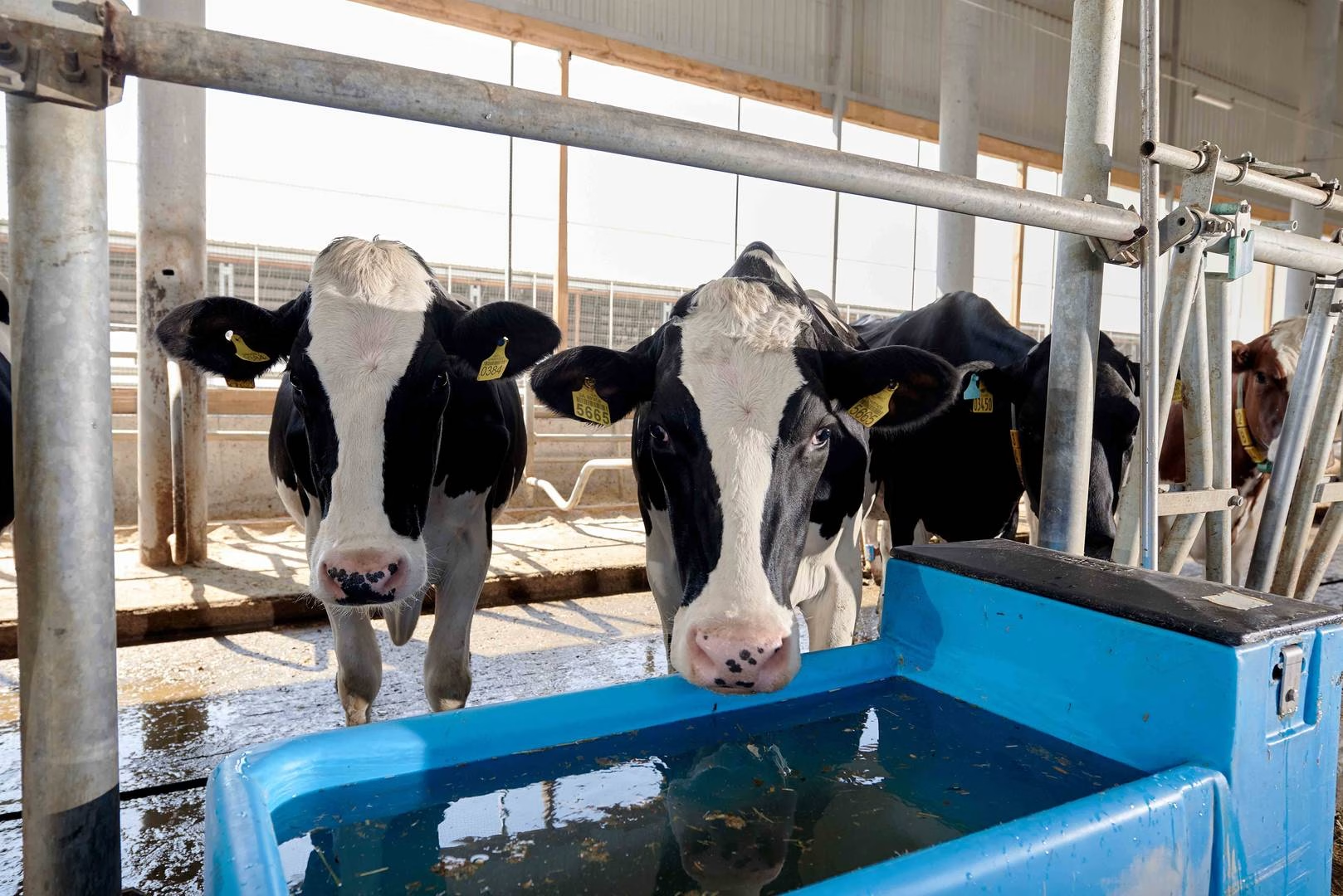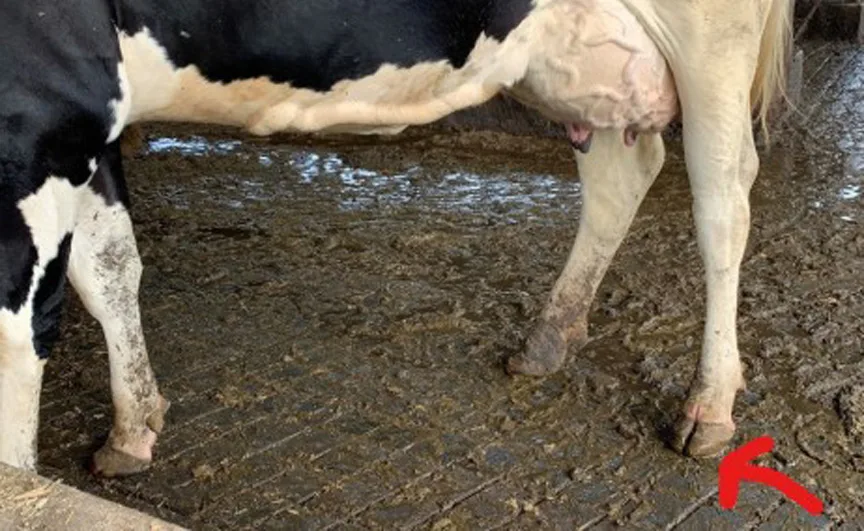Learn essential tips for handling dairy cattle in hot weather. Discover how to keep your cows cool and calm to maintain productivity and well-being.

On a sweltering summer day when shade is a distant memory, and the air hangs heavy with humidity, envision the struggle of a dairy cow striving to maintain productivity and well-being. Dairy producers invest heavily in fans, sprinklers, shade buildings, and other cooling systems to reduce heat stress in their herds. However, poor handling methods in these repressive environments might compromise these initiatives, so carefully managing our surroundings and interactions with cattle in high temperatures is critical. A primary concern from heat stress in dairy cattle is damaging animal health and sharply reducing milk supply. When the temperature-humidity index (THI) reaches 68, cows experience heat stress. At the same time, individual responses vary; farmers have to be alert for indicators of heat stress rather than depending only on statistics. This paper gives dairy producers helpful advice for calm and efficient cow management in hot weather. First, grasping the interaction between handling methods and environmental cooling investments is essential. Farmers may guard the output and health of their herd from the master bath regardless of the difficulty of the weather. Those committed to the best dairy production methods must address heat stress holistically.
Understanding the Temperature-Humidity Index (THI): Your Key To Mitigating Cattle Heat StressPredicting heat stress in cattle depends critically on the Temperature-Humidity Index (THI). It emphasizes the way humidity and temperature interact. Usually starting at a THI of 68, cattle experience heat stress, lowering milk output.
Realizing that cattle react differentially to heat stress—even in the same environment—is crucial. Although THI facilitates heat stress planning, depending only on it might overlook early warning signals. Crucially, one should be watching animals for indicators of heat stress.
While disturbed animals might exceed 100 breaths per minute, average respiration rates fall between 25 and 50 breaths per minute. Indices also include behavioral changes, such as grouping together, more standing, and obvious pain.
THI and attentively observing cow behavior enable more efficient heat stress control. This guarantees production and animal welfare protection through cooling expenditures like sprinklers and fans.
A Proactive Approach: Identifying Early Signs of Heat Stress in Cattle
Finding heat stress in cattle requires meticulous observation of minute behavioral changes, often occurring before more noticeable symptoms. One of the first signs is a modest rise in respiratory rate, usually between 25 and 50 breaths per minute. This pace may treble to 100 breaths per minute as heat stress increases to indicate extreme pain.
Panting suggests that cattle’s body temperature regulation is failing. Behaves like grouping or standing more often might also show attempts to cool down from the heat.
Proactive monitoring is essential for reducing the worst consequences of heat stress. Timely intervention may be achieved by routinely monitoring breathing rates and noting behavioral changes such as excessive standing or crowding.
Good management techniques depend on careful, responsive surveillance of early heat stress indicators to guarantee cattle welfare and output during hot weather.
Minimizing Movement: A Crucial Strategy to Alleviate Cattle Heat Stress
Reducing heat stress also implies less cow movement in warmer weather. Moving cattle raises body temperature, increasing heat stress and compromising health and output. Moving cattle at more favorable periods, such as morning or dusk, might help reduce overheating.
It is essential to use optimum standards throughout these moves. Using fans and providing shade can help cattle to have less heat burden. Moving animals in smaller groups increases ventilation and lowers the total body heat in confined areas. This is particularly crucial in holding pens as crowding could lead to heated and demanding surroundings. Reducing the time cattle spend in headlocks and the size of holding pen groups can help to reduce stress.
If you must move cattle by trailer, steer clear of the warmest sections of the day and cut the animal count on each trip to lower the heat load. We can regulate our tension from handling even if we cannot control the temperature of the surroundings. Well-planned routines and calm, orderly movements may significantly reduce the effects of intense heat.
The Importance of Shade and Fans: Enhancing Cattle Comfort During High Temperatures
Using fans and providing shade helps cattle reduce heat stress at hot temperatures. At the same time, fans improve ventilation and support evaporative cooling—a process where heat is removed from the body through the evaporation of sweat. Shade structures lower direct heat load, thus producing a more relaxing atmosphere.
Small group movements of animals improve ventilation and help lower stress levels. Smaller gatherings significantly reduce overheating hazards by guaranteeing enough space and circulation and preventing congestion. This also helps decrease waiting and moving times, therefore lowering stress. Combined with careful planning, these techniques provide a more compassionate and effective hot-weather cow management system.
Navigating the Challenges of Holding Pens: Strategies to Alleviate Heat and Physical Stress in Cattle
Reducing heat and physical stress in cattle depends on reasonable control of holding pens. These enclosures may become hotspots where several cows create notable group body heat, known as the ‘heat load. ‘ Reducing the total heat load and improving airflow by minimizing the animals per pen helps Bjurstrom emphasize how little groups help to create less stressful surroundings.
Additionally, limiting the time cattle spend in headlocks or similar constraints is crucial. These physical restrictions might aggravate heat stress by raising anxiety. Extended constraint reduces the cows’ capacity to remove heat, generating pain and health hazards. Therefore, minimizing prolonged periods of constraint benefits animal well-being and increases the effectiveness of other heat-reducing measures.
Transporting Cattle: Essential Guidelines for Reducing Stress During High Temperatures
Moving animals in excessive temperatures requires careful preparation. To escape maximum heat, move them at more laid-back hours, such as early morning or late evening. Cut the animal count in each trailer to lower body heat generation and anxiety, guaranteeing improved comfort and airflow.
Vaccinating in the Heat: Timing is Key to Preventing Compounded Stress and Health Risks
Vaccination at high temps calls for precise timing to prevent stressing out livestock unnecessarily. Although a modest fever following vaccinations is standard, along with high THI, it might cause heat stroke. Plan a late evening or early morning vaccine to reduce this danger. This method guarantees that livestock remains solid and healthy in hot conditions.
The Bottom Line
Although dairy farms depend on investments in cooling equipment, destructive handling methods during hot weather, such as excessive prodding or overcrowding, might jeopardize their efficacy. Good management incorporates careful planning and use of cattle handling techniques rather than just tools. Essential elements include tracking early indicators of heat stress, reducing movement at high temps, using shade and fans, controlling holding pen conditions, and following the best procedures for vaccination and transportation.
Maintaining animal production and well-being in increasing temperatures depends on calm, well-orchestrated management. The key to reducing heat loads is moving livestock at prime times of the day and guaranteeing fewer, less disruptive movement groups.
The well-being of your cattle and farm output depends on intentional management techniques to help you manage stress. Use these techniques to keep your animals calm and healthy, guaranteeing a sustainable and compassionate agricultural environment.
Key Takeaways:
- Invest in animal-cooling methods such as fans, sprinklers, and shade to reduce heat stress.
- Monitor the Temperature-Humidity Index (THI) and observe cattle for early signs of heat stress.
- Minimize cattle movement and handle them during cooler parts of the day.
- Use shade, fans, and smaller group movements to facilitate airflow and reduce heat stress.
- Avoid overcrowded holding pens to prevent exacerbating physical and heat stress.
- Transport cattle during cooler periods and limit the number of animals per trailer.
- Schedule vaccinations early in the morning or late in the evening to avoid compounding stress.
- Maintain calm and well-planned handling practices to prevent additional heat stress.
Summary:
Dairy producers are investing in cooling systems to maintain productivity and well-being during hot weather. However, poor handling methods can compromise these initiatives, making it crucial to manage cattle interactions in high temperatures. Heat stress is a primary concern for dairy cattle, damaging animal health and reducing milk supply. Early signs of heat stress can be identified through meticulous observation of behavioral changes and proactive monitoring. Minimizing movement, using fans and shade, and moving animals in smaller groups can also help alleviate heat stress. Proper planning and use of cattle handling techniques are essential for good management, ensuring cattle are not only protected but also healthy.













